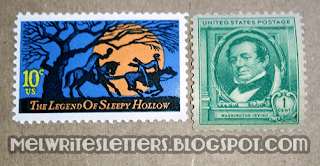Lately, I've been hearing a lot about people having mail returned to them, and struggling with the rules surrounding sending mail. I offered a couple of suggestions in an earlier blog post, Why I Collect Postage Stamps and How I Organize Them, but discovered yesterday that one of the links was broken. So I thought I'd do a series specifically about navigating the confusing and choppy waters of US Postal Service rules. Sometimes my mail takes its sweet time getting to its destination (most recently, it took 3 weeks for a letter to go ~50 miles), but as far as I know, they haven't arrived with postage due or come back to me..
Part 1 is just about the tools, because I don't want my focus to get buried (I have a tendency to ramble on). Part 2 will follow soon after, and will cover whatever else I can think of that might help.
This is going to be of more interest to individuals like me who would like to just drop their mail into a box whenever possible, and not stand in line for every little thing.
Recommended tools
Part 2 is already in progress, and covers what basic stamps you need, measurements, etc.
- Digital scale. In my opinion, this is an absolute necessity. You don't need a big scale to handle regular mail - a kitchen scale will do, as long as it displays partial ounces. (Fractions only matter after you cross the three-ounce mark. There is a 3.5 ounce rate, but otherwise, 1.1 ounce is the same as 2 ounces, and 2.1 ounces is the same as 3 ounces.)
- Bookmark the USPS price list (or print out the PDF (many pages)). The first section is a little grid that covers the basics of pricing letters and parcels.
- Bookmark the calculator. This will walk you through almost everything you need for domestic & international letters. The one thing you have to watch for is, just like at the counter, they start with the ridiculous options first and you have to dig for the regular first class costs.
- If you can get your hands on one, the Letter-size Mail Dimensional Standards Template (pictured above), aka Notice-3A (NOT3A) can be your best friend. I can't link to it, because all of the places I found for a printable one (legit & to scale) have been taken down. I'm not sure where mine came from, but I've had it for a couple of years and it's my buddy. It tells you at a glance if your envelope is too large to be considered a "letter." There's a slot in it: your envelope has to slide EASILY through the slot in order to go as a letter. If it sticks or doesn't fit, it jumps to package rates (a $2 difference for a 1 ounce envelope).
- How to get one:
- They are, I'm told, available at District Business Mail Entry offices. I don't know how that works, because mine is in Detroit, and even though I work in Detroit, I don't like driving around there (I get lost too easily). You might get lucky and find one nearby.
- You can order them from USPS customer service, but be prepared. The person I spoke to wasn't aware that civilians could order them and it took a while to get it worked out. They don't take credit cards, so you have to get your order set up, then get the details for sending a check and all the info. to include with it.
- The item number is: 7610-03-000-9053 (NOT3A)
- I recommend getting together with a group of local friends and ordering a bunch at once to save on shipping.
- You can get one from me, temporarily. I was so aggravated by how difficult the USPS has made it for people to access basic tools, that I am ordering ten. I'm keeping a couple for myself - because I like redundancy with this kind of thing - and I'll make available the rest for whatever I paid ($1.60 each) plus actual shipping. I will not make a dime off of this, guaranteed. To get one of the eight, email me at mel.writes.letters at gmail dot com or DM me on Instagram.
- Tape measure, for large envelopes or parcels.
Part 2 is already in progress, and covers what basic stamps you need, measurements, etc.


















